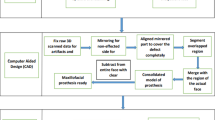Abstract
Purpose
This study describes the workflow in a procedure to create a provisional facial prosthesis for cancer patients using digital and rapid prototyping technologies without the need for supporting craniofacial implants.
Materials and methods
An integrated workflow procedure aimed at the construction of provisional silicone prosthesis was used to rehabilitate a facial disfigurement in a patient who had undergone ablative surgery of the midface. A laser scan of the defect was obtained, and a digital model of the patient′s face was constructed using virtual mirroring of the healthy side and referencing the “Nose Digital Library.”
Results
The missing volume of the face was reconstructed, and a rapid-prototyped mold was devised to process the silicone prosthesis. A provisional eyeglasses-supported prosthesis designed with a CAD/CAM-projected titanium substructure was connected using the micro-components of implant prosthetic devices.
Conclusions
The workflow described herein offers a viable procedure for quickly restoring facial defects by means of provisional prosthetic rehabilitation.






Similar content being viewed by others
References
Ciocca L, Mingucci R, Gassino G, Scotti R (2007) CAD/CAM ear model and virtual construction of the mold. J Prosthet Dent 98:339–343. doi:10.1016/S0022-3913(07)60116-4
Ciocca L, Scotti R (2004) CAD–CAM generated ear cast by means of a laser scanner and rapid prototyping machine. J Prosthet Dent 92:591–595. doi:10.1016/j.prosdent.2004.08.021
Mardini MA, Ercoli C, Grasser GN (2005) A technique to produce a mirror-image wax pattern of an ear using rapid prototyping technology. J Prosthet Dent 94:195–198. doi:10.1016/j.prosdent.2005.04.019
Beumer J, Curtis TA, Marunick MT (1998) Maxillofacial rehabilitation: prosthetic and surgical consideration. Elsevier, St. Louis, pp 377–453
Hecker DM (2003) Maxillofacial rehabilitation of a large facial defect resulting from an arterovenous malformation utilizing a two-piece prosthesis. J Prosthet Dent 89:109–113. doi:10.1067/mpr.2003.23
Girod S, Keeve E, Girod B (1995) Advances in interactive craniofacial surgery planning by 3D simulation and visualization. Int J Oral Maxillofac Surg 24:120–125. doi:10.1016/S0901-5027(05)80872-0
Coward TJ, Watson RM, Wilkinson IC (1999) Fabrication of a wax ear by rapid-process modeling using stereolithography. Int J Prosthodont 12:20–27
Penkner K, Santler G, Mayer W, Pierer G, Lorenzoni M (1999) Fabricating auricular prosthesis using three-dimensional soft tissue model itself. J Prosthet Dent 82:482–484. doi:10.1016/S0022-3913(99)70038-7
Runte C, Dirksen D, Delerè H, Thomas C, Runte B, Meyer U, Von Bally G, Bollmann F (2002) Optical data acquisition for computer-assisted design of facial prostheses. Int J Prosthodont 15:129–132
Reitemeier B, Notni G, Heinze M, Schone C, Schmidt A, Fichtner D (2004) Optical modeling of extraoral defects. J Prosthet Dent 91:80–84. doi:10.1016/j.prosdent.2003.10.010
Nusinov NS, Gay WD (1980) A method for obtaining the reverse image of an ear. J Prosthet Dent 44:68–71. doi:10.1016/0022-3913(80)90049-9
Mankovich NJ, Curtis DA, Kagawa T, Beumer J III (1986) Comparison of computer-based fabrication of alloplastic cranial implants with conventional techniques. J Prosthet Dent 55:606–609. doi:10.1016/0022-3913(86)90041-7
Lemon JC, Okay DJ, Powers JM, Martin JW, Chambers MS (2003) Facial moulage: the effect of a retarder on compressive strength and working and setting times of irreversible hydrocolloid impression material. J Prosthet Dent 90:276–281. doi:10.1016/S0022-3913(03)00366-4
Sander A, Bloching M (2009) Retrospective analysis of titanium plate-retained prostheses placed after total rhinectomy. Int J Oral Maxillofac Implants 24:118–123
Author information
Authors and Affiliations
Corresponding author
Rights and permissions
About this article
Cite this article
Ciocca, L., Fantini, M., Marchetti, C. et al. Immediate facial rehabilitation in cancer patients using CAD–CAM and rapid prototyping technology: a pilot study. Support Care Cancer 18, 723–728 (2010). https://doi.org/10.1007/s00520-009-0676-5
Received:
Accepted:
Published:
Issue Date:
DOI: https://doi.org/10.1007/s00520-009-0676-5




